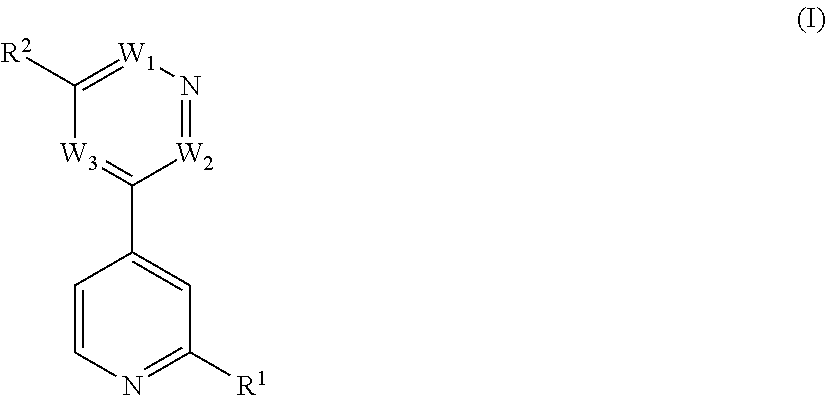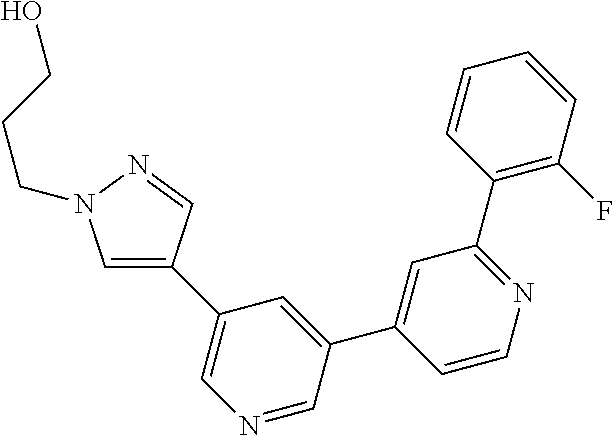Bipyridyl derivatives
a technology of bipyridyl derivatives and derivatives, which is applied in the field of bipyridyl derivatives, can solve the problems of bipyridyl derivatives that bipyridyl derivatives are not disclosed in international applications, and overexpression is associated with both worse patient outcomes and metastases
- Summary
- Abstract
- Description
- Claims
- Application Information
AI Technical Summary
Benefits of technology
Problems solved by technology
Method used
Image
Examples
example 1
Synthesis of 2-(5-Chloro-2-fluoro-phenyl)-pyridine-4-boronic acid
[0258][0259]1. A solution of 2.96 g (20.0 mmol) 2,4-dichloropyridine, 3.49 g (20.0 mmol) 5-chloro-2-fluorobenzeneboronic acid and 2.02 g (20.0 mmol) sodium bicarbonate in 40 ml DMF and 20 ml water is heated to 80° C. under nitrogen. 281 mg (0.40 mmol) bis-(triphenylphosphine)-palladium(II)-chloride are added and the mixture is stirred for 16 hrs at 80° C. Water is added to the reaction mixture and the resulting precipitate is filtered off and washed well with water. The residue is dried under vacuum to yield 4-chloro-2-(5-chloro-2-fluoro-phenyl)-pyridine as pink solid; HPLC-MS: 2.75 min, [M+H] 242.[0260]2. 4.68 g (19.3 mmol) 4-chloro-2-(5-chloro-2-fluoro-phenyl)-pyridine are dissolved in 60 ml THF and 10 ml of a 4 N solution of hydrochloric acid in dioxane are added. The solution is evaporated and the residue dried under vacuum. A slurry of this solid in 200 ml acetonitrile is treated with 29.0 g (193 mmol) sodium iodi...
example 2
Synthesis of 5-bromo-2′-chloro-[3,4′]bipyridinyl
[0263]
[0264]A solution of 9.63 g (33.9 mmol) 3-bromo-5-iodopyridine, 4.85 g (30.8 mmol) 2-chloro-pyridine-4-boronic acid and 3.11 g (37.0 mmol) sodium bicarbonate in 120 ml DMF and 30 ml water is heated to 80° C. under nitrogen. 433 mg (0.616 mmol) bis-(triphenylphosphine)-palladium(II)-chloride are added and the mixture is stirred for 4 hrs at 80° C. Water is added to the reaction mixture and the resulting precipitate is filtered off and washed well with water. The residue is dried under vacuum and recrystallized from 2-propanol yielding 5-bromo-2′-chloro-[3,4′]bipyridinyl as brown crystals; HPLC-MS: 2.16 min, [M+H] 271.
[0265]1H NMR (400 MHz, DMSO) δ=9.06 (d, J=2.0, 1H), 8.83 (d, J=2.1, 1H), 8.60 (t, J=2.1, 1H), 8.53 (d, J=5.2, 1H), 8.04 (d, J=1.6, 1H), 7.89 (dd, J=5.2, 1.6, 1H).
I.2 Synthesis of Final Compounds
example 3
Synthesis of 2′-(5-chloro-2-fluoro-phenyl)-5-(1-piperidin-4-yl-1H-pyrazol-4-yl)-[3,4′]bipyridinyl and 2′-(5-chloro-2-fluoro-phenyl)-5-[1-(1-methyl-piperidin-4-yl)-1H-pyrazol-4-yl]-[3,4′]bipyridinyl
[0266][0267]1. A slurry of 2.50 g (8.81 mmol) 3-bromo-5-iodo-pyridine, 3.66 g (9.7 mmol) 4-[4-(4,4,5,5-tetramethyl-[1,3,2]dioxaborolan-2-yl)-pyrazol-1-yl]-piperidin-1-carboxylic acid tert.butyl ester (synthesis described in WO 2007 / 066187) and 3.74 g (17.6 mmol) tri-potassium-phosphate-trihydrate in 30 ml 1,2-dimethoxyethane is heated to 80° C. under nitrogen. Then 618 mg (0.88 mmol) bis-(triphenylphosphine)-palladium(II)-chloride are added. The reaction mixture is stirred for 16 hours at 80° C. The reaction mixture is partitioned between THF and brine. The organic phase is dried over sodium sulfate and evaporated yielding 4-[4-(5-bromo-pyridin-3-yl)-pyrazol-1-yl]-piperidine-1-carboxylic acid tert-butyl-ester as slightly yellow crystals; HPLC-MS: 2.28 min, [M+H] 407 / 409.[0268]2. A slurry o...
PUM
| Property | Measurement | Unit |
|---|---|---|
| molecular weight | aaaaa | aaaaa |
| temperature | aaaaa | aaaaa |
| temperature | aaaaa | aaaaa |
Abstract
Description
Claims
Application Information
 Login to View More
Login to View More - R&D
- Intellectual Property
- Life Sciences
- Materials
- Tech Scout
- Unparalleled Data Quality
- Higher Quality Content
- 60% Fewer Hallucinations
Browse by: Latest US Patents, China's latest patents, Technical Efficacy Thesaurus, Application Domain, Technology Topic, Popular Technical Reports.
© 2025 PatSnap. All rights reserved.Legal|Privacy policy|Modern Slavery Act Transparency Statement|Sitemap|About US| Contact US: help@patsnap.com



